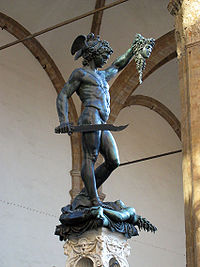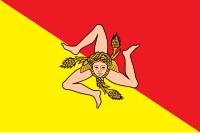Medusa
From Wikipedia, the free encyclopedia
| This article includes a list of references or external links, but its sources remain unclear because it has insufficient inline citations. Please help to improve this article by introducing more precise citations where appropriate. |

| Topics in Greek mythology |
|---|
|
|
|
In Greek mythology, Medusa (Greek: Μέδουσα (Médousa), "guardian, protectress"[1]) was a gorgon, a chthonic female monster; gazing upon her would turn onlookers to stone. She was beheaded by the hero Perseus, who thereafter used her head as a weapon[2] until giving it to the goddess Athena to place on her shield. In classical antiquity and today, the image of the head of Medusa finds expression in the evil-averting device known as the Gorgoneion. She also has two gorgon sisters.
Contents |
[edit] Medusa in classical mythology
[edit] Family

The three Gorgon sisters — Medusa, Stheno, and Euryale — were children of the ancient marine deities Phorcys and his sister Ceto, or sometimes, Typhon and Echidna, in each case chthonic monsters from an archaic world. Their genealogy is shared with other sisters, the Graeae, as in Aeschylus's Prometheus Bound, who places both trinities of sisters far off "on Kisthene's dreadful plain":
Near them their sisters three, the Gorgons, winged
With snakes for hair— hated of mortal man—
While ancient Greek vase-painters and relief carvers imagined Medusa and her sisters as beings born of monstrous form, sculptors and vase-painters of the fifth century began to envisage her as a being both beautiful as well as terrifying. In an ode written in 490 BC Pindar already speaks of "fair-cheeked Medusa".[3] In a late version of the Medusa myth, related by the Roman poet Ovid (Metamorphoses 4.770), Medusa was originally a beautiful maiden, "the jealous aspiration of many suitors," priestess in Athena's temple, but when she made love to the "Lord of the Sea" Poseidon in Athena's temple, the enraged goddess transformed her beautiful hair to serpents and she made her face so terrible to behold that the mere sight of it would turn a man to stone. In Ovid's telling, Perseus describes Medusa's punishment by Athena as just and well-deserved.
[edit] Death
In the majority of the versions of the story, while Medusa was pregnant by Poseidon, she was beheaded by the hero Perseus, who was sent to fetch her head by King Polydectes of Seriphus as a gift. With help from Athena and Hermes, who supplied him with winged sandals, Hades' cap of invisibility, a sword, and a mirrored shield, he accomplished his quest. The hero slew Medusa by looking at her reflection in the mirror instead of directly at her to prevent being turned into stone. When the hero severed Medusa's head from her neck, two offspring sprang forth: the winged horse Pegasus and the giant Chrysaor who later became the hero wielding the golden sword.

Jane Ellen Harrison argues that "her potency only begins when her head is severed, and that potency resides in the head; she is in a word a mask with a body later appended... the basis of the Gorgoneion is a cultus object, a ritual mask misunderstood."[4]
In Odyssey xi, Homer does not specifically mention the Gorgon Medusa:
lest for my daring Persephone the dread
From Hades should send up an awful monster's grizzly head
Harrison's translation states "the Gorgon was made out of the terror, not the terror out of the Gorgon."[4]
According to Ovid, in North-West Africa Perseus flew past the Titan Atlas, who stood holding the sky aloft, and transformed him into stone. In a similar manner, the corals of the Red Sea were said to have been formed of Medusa's blood spilled onto seaweed when Perseus laid down the petrifying head beside the shore during his short stay in Aethiopia where he saved and wed his future wife, the lovely princess Andromeda. Furthermore the poisonous vipers of the Sahara, in the Argonautica 4.1515, Ovid's Metamorphoses 4.770 and Lucan's Pharsalia 9.820, were said to have grown from spilt drops of her blood.
Perseus then flew to his mother's island where she was about to be forced into marriage with the king. He cried out "Mother, shield your eyes", and everyone but his mother was turned into stone by the gaze of Medusa's head.
Then he gave the Gorgon's head to Athena, who placed it on her shield, the Aegis.
Some classical references refer to three Gorgons; Harrison considered that the tripling of Medusa into a trio of sisters was a secondary feature in the myth:
The triple form is not primitive, it is merely an instance of a general tendency... which makes of each woman goddess a trinity, which has given us the Horae, the Charites, the Semnai, and a host of other triple groups. It is immediately obvious that the Gorgons are not really three but one + two. The two unslain sisters are mere appendages due to custom; the real Gorgon is Medusa.[4]
[edit] Modern interpretations
[edit] Psychoanalysis
In 1940, Sigmund Freud's Das Medusenhaupt (Medusa's Head) was published posthumously. This article laid the framework for his significant contribution to a body of criticism surrounding the monster. Medusa is presented as “the supreme talisman who provides the image of castration — associated in the child's mind with the discovery of maternal sexuality — and its denial.”[5][6] Psychoanalysts continue archetypal literary criticism to the present day. 2002's The Rape of Medusa in the Temple of Athena: Aspects of Triangulation in the Girl by Dr. Beth Seeley, analyzes Medusa's punishment for the “crime” of having been raped in Athena's temple as an outcome of the goddess' unresolved conflicts with her father, Zeus.[7]
[edit] Feminism
In the 20th century, feminists reassessed Medusa's appearances in literature and in modern culture, including the use of Medusa as a logo by fashion company Versace.[8][9][10] The name "Medusa" itself is often used in ways not directly connected to the mythological figure but to suggest the gorgon's abilities or to connote malevolence; despite her origins as a beauty, the name in common usage "came to mean monster."[11] The book Female Rage: Unlocking Its Secrets, Claiming Its Power by Mary Valentis and Anne Devane notes that "When we asked women what female rage looks like to them, it was always Medusa, the snaky-haired monster of myth, who came to mind ... In one interview after another we were told that Medusa is 'the most horrific woman in the world' ... [though] none of the women we interviewed could remember the details of the myth."[12]
Medusa has also been adopted as a symbol of female rage; one of the first publications to express this idea was a 1978 issue of Women: A Journal of Liberation. The cover featured the image of a gorgon, which the editors explained "can be a map to guide us through our terrors, through the depths of our anger into the sources of our power as women."[12] In a 1986 article for Women of Power magazine called "Ancient Gorgons: A Face for Contemporary Women's Rage," Emily Erwin Culpepper wrote that "The Amazon Gorgon face is female fury personified. The Gorgon/Medusa image has been rapidly adopted by large numbers of feminists who recognize her as one face of our own rage."[12]
[edit] Medusa in art

From ancient times, the Medusa was immortalized in numerous works of art, including:
- Medusa on the breastplate of Alexander the Great, as depicted in the Alexander Mosaic from Pompeii's House of the Faun (c. 200 BC)
- The "Rondanini Medusa", a Roman copy of the Gorgoneion on the aegis of Athena
- Medusa (oil on canvas) by Leonardo da Vinci
- Perseus with the Head of Medusa (bronze sculpture) by Benvenuto Cellini (1554)
- Medusa (oil on canvas) by Caravaggio (1597).
- Tête de Méduse, by Peter Paul Rubens (1618)
- Perseus Turning Phineus and his Followers to Stone (oil on canvas) by Luca Giordano (early 1680s).
- Perseus with the Head of Medusa (marble sculpture) by Antonio Canova (1801)
- Medusa (oil on canvas) by Arnold Böcklin (c. 1878)
- Perseus (bronze sculpture) by Salvador Dalí
Medusa remained a common theme in art in the nineteenth century, when her myth was retold in Thomas Bulfinch's Mythology. Edward Burne-Jones' Perseus Cycle of paintings and a drawing by Aubrey Beardsley gave way to the twentieth century works of Paul Klee, John Singer Sargent, Pablo Picasso, and Auguste Rodin's bronze sculpture The Gates of Hell.[13]
[edit] Medusa as a symbol
The head of Medusa is featured on some regional symbols. One example is that of the flag and emblem of Sicily, together with the three legged trinacria. The inclusion of Medusa in the center implies the protection of the goddess Athena, who wore the Gorgon's likeness on her aegis, as said above. Another example is the coat of arms of Dohalice village in the Czech Republic.
[edit] Notes and references
- ^ Probably the feminine present participle of medein, "to protect, rule over" (American Heritage Dictionary; compare Medon, Medea, Diomedes, etc.). If not, it is from the same root, and is formed after the participle. OED 2001 revision, s.v.; medein in LSJ.
- ^ Bullfinch, Thomas. "Bulfinch Mythology - Age of Fable - Stories of Gods & Heroes". http://classiclit.about.com/library/bl-etexts/tbulfinch/bl-tbulfinch-age-15.htm. Retrieved on 2007-09-07. "...and turning his face away, he held up the Gorgon’s head. Atlas, with all his bulk, was changed into stone."
- ^ (Pythian Ode 12). Noted by Marjorie J. Milne in discussing a red-figured vase in the style of Polygnotos, ca. 450-30 BC, in the Metropolitan Museum of Art; Milne noted that "It is one of the earliest illustrations of the story to show the Gorgon not as a hideous monster but as a beautiful woman. Art in this respect lagged behind poetry." (Marjorie J. Milne, "Perseus and Medusa on an Attic Vase" The Metropolitan Museum of Art Bulletin New Series, 4.5 (January 1946, pp. 126-130) 126.p.)
- ^ a b c Jane Ellen Harrison, (1903) 3rd ed. 1922. Prolegomena to the Study of Greek Religion. "The Ker as Gorgon." Pg.187.
- ^ Medusa in Myth and Literary History
- ^ Das Medusenhaupt (Medusa's Head. First published posthumously. Int. Z. Psychoanal. Imago, 25 (1940), 105; reprinted Ges. W., 17,47. The manuscript is dated May 14, 1922, and appears to be a sketch for a more extensive work. Translation, reprinted from Int. J. Psychoanal.,22 (1941), 69; by James Strachey.
- ^ Seelig, B.J. (2002). The Rape of Medusa in the Temple of Athena: Aspects of Triangulation. Int. J. Psycho-Anal., 83:895-911.
- ^ Pratt, A. (1994). Archetypal empowerment in poetry: Medusa, Aphrodite, Artemis, and bears : a gender comparison. Bloomington: Indiana University Press. ISBN 0253208653
- ^ Stephenson, A. G. (1997). "Endless the Medusa: a feminist reading of Medusan imagery and the myth of the hero in Eudora Welty's novels."
- ^ Garber, Marjorie. The Medusa Reader, February 24, 2003, ISBN 0-415-90099-9, Introduction, pg. 7.
- ^ Garber, Medusa Reader, Introduction, pg. 1
- ^ a b c Wilk, Stephen R. Medusa: Solving the Mystery of the Gorgon, June 26, 2000, pg. 217-218, ISBN 0-195-12431-6.
- ^ Wilk, Medusa: Solving the Mystery of the Gorgon, pg. 200.
[edit] See also
[edit] External links
- Ancient coins depicting Medusa
- "Medusa in Myth and Literary History" - English.uiuc.edu
- On the Medusa of Leonardo Da Vinci in the Florentine Gallery, by Percy Bysshe Shelley
- Theoi Project, Medousa & the Gorgones References to Medusa and her sisters in classical literature and art
[edit] References
[edit] Primary sources
| Wikimedia Commons has media related to: Medusa |
- Servius, In Aeneida vi.289
- Lucan, Bellum civile ix.624-684
- Ovid, Metamorphoses iv.774-785, 790-801
[edit] Secondary sources
- Jane Ellen Harrison, (1903) 3rd ed. 1922. Prolegomena to the Study of Greek Religion,: "The Ker as Gorgon"



